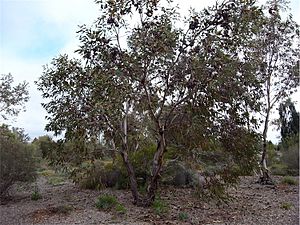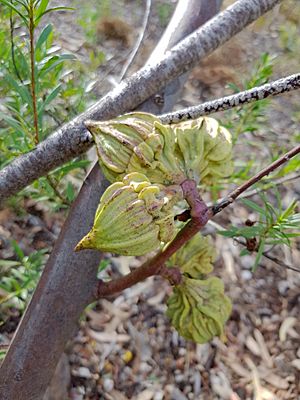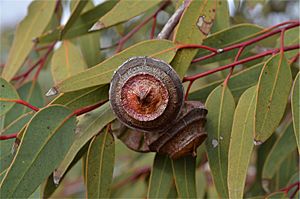Large-fruited mallee facts for kids
Quick facts for kids Large-fruited mallee |
|
|---|---|
 |
|
| Eucalyptus youngiana in the Australian Arid Lands Botanic Garden | |
| Scientific classification | |
| Genus: |
Eucalyptus
|
| Species: |
youngiana
|

The Large-fruited Mallee (Eucalyptus youngiana) is a special type of mallee plant. Sometimes it grows as a small tree. It is also known as Ooldea mallee and yarldarlba. You can find it in the dry and semi-dry parts of southern Western Australia and South Australia. This plant has rough, stringy bark on its trunk and smooth bark higher up. Its leaves are shaped like spears, and its flowers can be red, pink, or bright yellow. After flowering, it grows unique, broad, cone-shaped fruits.
Contents
What is the Large-fruited Mallee?
The Eucalyptus youngiana is usually a mallee, which means it's a type of eucalyptus that grows many stems from a swollen base called a lignotuber. It typically reaches a height of about 4 to 8 meters (13 to 26 feet). Sometimes, it can grow taller, up to 10 meters (33 feet), like a small tree.
What Does it Look Like?
This plant has rough, flaky bark that is dark grey-brown on the lower part of its trunk. Higher up, the bark is smooth and can be pinkish-grey or creamy.
Young plants and new shoots (called coppice regrowth) have greyish-green leaves. These leaves are shaped like an egg or a spear, measuring about 70 to 160 millimeters (2.8 to 6.3 inches) long and 25 to 45 millimeters (1.0 to 1.8 inches) wide.
The adult leaves are a dull bluish-green on both sides and are shaped like a spear. They are about 85 to 170 millimeters (3.3 to 6.7 inches) long and 15 to 37 millimeters (0.6 to 1.5 inches) wide. Each leaf narrows down to a stalk called a petiole, which is 15 to 32 millimeters (0.6 to 1.3 inches) long.
Flowers and Fruit
The flower buds grow in groups of three in the leaf axils (the spot where a leaf joins the stem). These groups are on a single stalk called a peduncle, which is 10 to 25 millimeters (0.4 to 1.0 inch) long. Each individual bud has its own small stalk, or pedicel, about 5 to 15 millimeters (0.2 to 0.6 inches) long.
When the buds are ready, they are oval-shaped, about 45 to 60 millimeters (1.8 to 2.4 inches) long and 30 to 45 millimeters (1.2 to 1.8 inches) wide. They have a horn-shaped or beaked cap called an operculum, which is 28 to 42 millimeters (1.1 to 1.7 inches) long.
The Large-fruited Mallee flowers from June to October. Its flowers can be red, pink, or bright yellow, making them quite striking!
After the flowers, the plant produces a woody fruit. This fruit is a short, broad, and half-sphere shaped capsule, measuring 15 to 30 millimeters (0.6 to 1.2 inches) long and 33 to 60 millimeters (1.3 to 2.4 inches) wide. It has rough ridges running along its length. Inside, the seeds are brown, shaped like an irregular pyramid, and are about 2.5 to 4 millimeters (0.10 to 0.16 inches) long.
How Did it Get Its Name?
The scientific name for this plant, Eucalyptus youngiana, was first officially described in 1876 by a famous botanist named Ferdinand von Mueller. He wrote about it in his book Fragmenta phytographiae Australiae.
Mueller named the plant after Jess Young. Jess Young was a member of Giles's fourth expedition in May 1875. Jess Young collected the first sample of this plant near Queen Victoria Spring, which helped Mueller identify and name it.
Where Does it Grow?
The Large-fruited Mallee prefers to grow in sandy soil on flat land. You often find it growing alongside Triodia species, which are a type of spinifex grass.
This plant is found in dry (arid) and semi-dry (semi-arid) regions. Its range stretches from north of Kalgoorlie in Western Australia, across the vast Great Victoria Desert, all the way to Tarcoola and Bulgunnia Station in South Australia.



